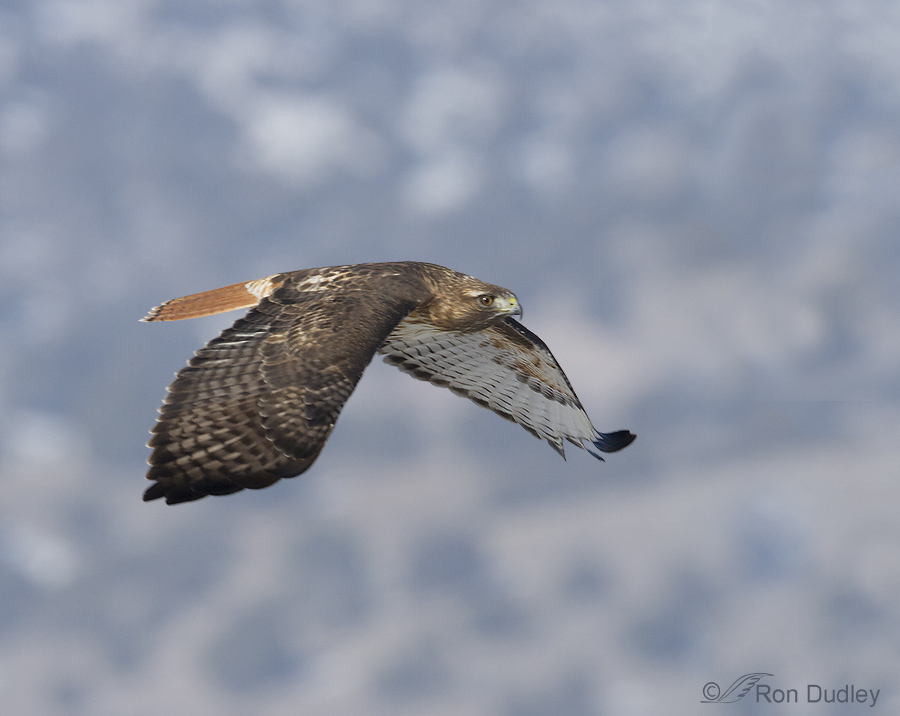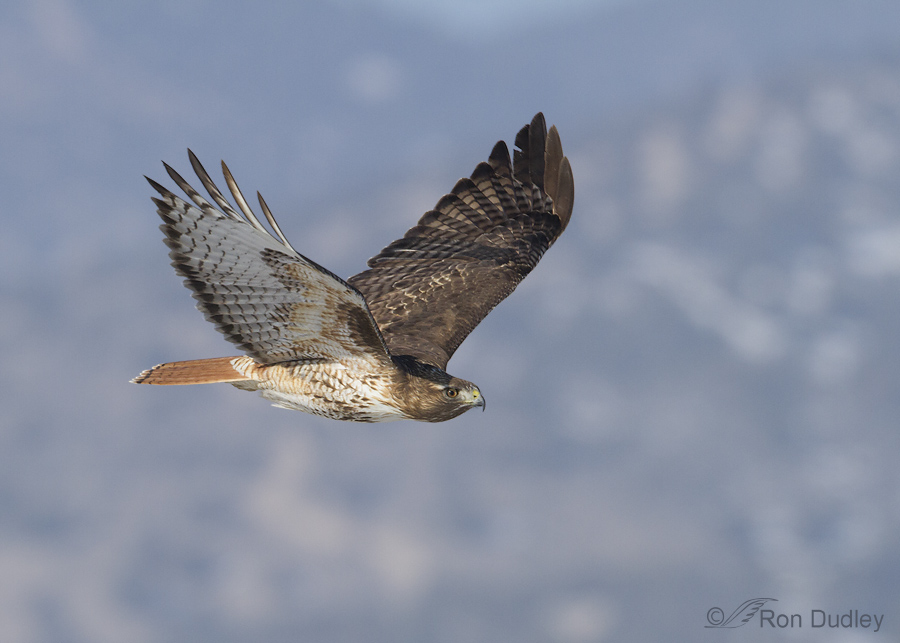I like the backgrounds provided by western mountains for birds in flight but as I’ve said previously backdrops with texture make it more difficult to get sharp focus lock on the bird.
1/1600, f/8, ISO 500, Canon 7D, 500 f/4, canvas added for composition, not baited, set up or called in
These are the Oquirrh Mountains of northern Utah two weeks ago. The patches of snow mixed with trees and bare soil provide the texture that makes the background more interesting than cloudless sky but also makes it more challenging to get focus locked onto the bird. Here the mountains are far enough away to make the task a little easier, even though this image isn’t quite tack sharp.
1/1600, f/8, ISO 500, Canon 7D, 500 f/4, not baited, set up or called in
In this frame I caught the wings up which caused a shadow on top of the head and neck that may not be ideal but I certainly don’t think it ruins the shot. Reflected light from snow on the ground provided good detail on the shaded underside of the right wing.
This hawk was in full flight rather than just after takeoff as indicated by its flight posture and tucked feet. In this second shot I like the wing position, light, background and the good look at the red tail.
Ron




Despite their relative abundance, a strikingly colorful Red-tail (in flight!) never disappoints!
Ron,
I’ve so many times wanted to talk about the emotions that your photographs elicit.It’s my emotional response that chooses “my favorite shot”. As a birder and an artist, I can truly appreciate the beauty of your photograps. My “nature photography ” stopped when I realized that I was so focused on the camera that I really had no feeling for what I had seen or where I had been. So, you are providing incredible images from nature and I can experience them fully without having to dilute the experience with camera parafhenalia, technique, etc.
All of your photograps are technically amazing. However, the ones that call to me have: 1. grasses, twigs, branches, ground…habitat that unconsciously invites me into the photograph, because I’ve been in similar habitat when birding and I’m now remembering how that feels. A feeling of the habitat helps me have an emotional reaponse to the photograph. 2. a varition in lighting, Shadows create areas that I have to look again, and then I may see other surrounding details that I would have missed if the whole scene were equally lit.Of the two red tail images, #1 is equally lit. Nothing intrigues me to look closer. #2, however, has that shadow that calls me to look at it, and I see that the shadow is about the same size and shape as the dark area of the underside of the right wing. interesting, now I’m focused and looking at other details that I didn’t bother to look at on imag#1. 3. movement/energy shot#2, with the right primaries…energy energizes me.4.detail..#2 shows both underside and topside of wings. look at all that detail to explore when we are able to focus down. It was the shadow that brought my focus into the details..and I noticed that beautiful area of white spotting on the topside of the left wing. I always look for that light “chevron” on the back of perched red tais, as an I.D. It was great to see it in this bird.
I could go on….I just want to share with you how I respond to them. They have the ability to take me out into the field which is where I long to be 24 hours a day. You add a lot to my joy.
Thank you!
SUE
I agree…..
Interesting to read your comment, Sue. I probably let the technical aspects play a bigger part than I should in choosing my “favorites” but emotional response is still a big part of it.
In the bird photography world, many refer to two major types of shots – “BIH” (bird in habitat) and “BOS” (bird on a stick). I’m like you in that I prefer the former when they’re well taken. But they’re more difficult in many ways too because the habitat often has its own issues.
Thank you for the detailed and heart-felt comment!
I agree, Mike. Thank you.
Sensational shots Ron! Thanks for sharing!
Charlotte
Thanks, Charlotte.
Changed my mind…revisited this site, now my favorite I’d the first image…love the concentration in the bird’s focus and implied power of the stroke…these are both great images…
nice shots – red tails are especially skittish when approaching – even when I shoot from the car – or maybe it’s different in Utah – having them fly horizontally to your shot instead of just “butt shots” takes patience – or some special skill… the side shots show their form (and beak) nicely
Barb, The approachability of our Red-tails varies tremendously from bird to bird. Most are quite skittish but a few get used to roads and traffic and become much “stickier” when you’re shooting from a vehicle.
Hi Ron!
I’d be interested in the reasons for the preferences for image #2. I have a theory, and would like to check it out.
SUE
Sue, For me it’s because image #2 is slightly sharper and because I prefer the wings in the up position in this case. Another reason is that I didn’t have to add canvas to image #2 like I did #1.
Beautiful shots…esp. the second with that focused look and classic wing position. Once again, I’m struck by the flex in the outer ends of the primaries and wonder how much that constant flexing wears them out. Interesting comments about “coping”…had never heard the term, though knew how important beak health is to birds…ex. parakeets, cockatiels and parrots.
Patty, I’ve watched a few videos of birds going through the coping process – pretty interesting and probably not much fun for the bird. Makes me wonder how often it typically has to be done.
My birds did it themselves…on cuttlefish, “stones”, blocks,perches and regular small garden stones…the idea of doing it to them or for them gives me the creeps….
Coping sounds like as much fun to undergo…or watch…as “floating” a horse’s teeth!!!
Wonderful in-fight shots Ron ! That awesome red tail really pops with the muted mountain background.
You’re right about the tail against that background, John. Thank you.
Beautiful! The second one is perfection. I think I could look at it for hours and still find something new.
Thanks very much, Leisa.
Love both shots! It’s interesting, when I first looked and the background of the firs image, I thought the background was blotchy clouds until I read your comments. I can more easily see that’s not the case in the second image.
An easy assumption to make, Sharon – they do look a bit like clouds.
Outstanding…..as usual. Thank you Ron.
Thank you, Steve.
Beautiful images Ron!
Something I find myself doing with some of your shots is inspecting the state the beak. As a falconer, one of our jobs is to maintain the beak though coping. A healthy bird can grow the beak at a decent rate. Taking reference pictures is helpful to return the beak back to the best form. 24/7 in the wild hawks manage the sharpness with the use of prey, rocks and wood. In the muse (hawk house), its hard to give them those things because foot care is more important. In other words they will perch on anything they can without regard for their feet. So it falls on the falconer to cope the beak. These pictures are awesome, they show so clearly a very impressive tool for survival.
Tim
I love getting your falconer’s perspective on some of these things, Tim. Thanks for that (and please keep it up!)
Hi Ron
I love that second shot. Magnificent!
Thanks, Paul. That’s also my favorite of the two.